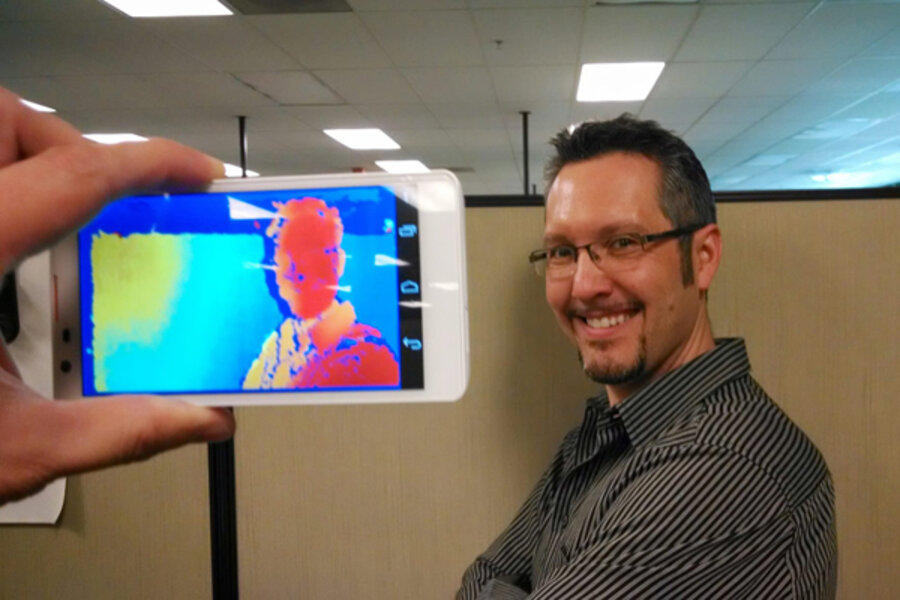A look inside Google's 3-D mapping Tango phone and tablet
Loading...
As the first app developer outside of Google Labs to get his hands on both the new Tango phone and tablet, Trimble director Omar-Pierre Soubra is the one to talk to if you want to fill your dance card with Tango’s best moves. Google's Project Tango initiative is pushing the bounds of virtual experiences and realistic mapping on mobile devices.
In February, Google introduced the Tango phone, which can sense and map out objects around it, creating a 3-D model of the physical world. The subsequent Tango tablet comes full of sensors, a motion-tracking camera, and 128 gigabytes of storage.
“The first thing I did when I got the Tango phone back in March was take and post a 3-D selfie,” Mr. Soubra says in a phone interview from his home in Westminster, Colo. “I was showing off. It’s very exciting technology.”
Selfies aside, as one of the elite among the pioneer developers outside Google Labs, Soubra is also among the first to run headlong into the products’ current barriers.
In his time with the cutting-edge devices, Soubra has encountered issues with very short battery life; the phone becoming hot to the touch when multitasking; and an inability to detect certain surfaces, such as glass and outdoor objects.
Having graduated to the Tango tablet well before its unveiling this week, Soubra found that Google has solved some of these issues. The Tango tablet has “a much longer battery life, takes longer to exhibit heating issues, and is more of an app-friendly environment in which to both shoot and process 3-D mapping, scanning, and environment creation,” Soubra says.
“Unfortunately, the devices still really don’t work very well outdoors,” he explains. “It has to do with the depth-perception infrared scanner at this point. [Project Tango developers inside Google] are well on the way to addressing that. However, for now, it’s best to use the devices indoors.”
Soubra is an exception when it comes to having one of these devices in hand. The new tablet will not be made available to most software developers until late June.
As far as being able to operate these two new Tango devices, no fancy footwork is involved.
“It is exactly the same thing as using an Android phone,” Soubra says. “Your system is pretty much exactly the same. There is no learning curve on that aspect.”
One developer who is still waiting to get his hands on a Tango device is Kevin Gallup, a sculptor and 3-D scanning inventor in Pensacola, Fla.
Mr. Gallup holds a patent, issued in 2007, for a device used to 3-D scan surfaces.
Gallup says he ran into some of the same issues in 2007 that Tango has encountered today, such as the ability to scan clear or opaque surfaces, like glass.
However Gallup isn’t looking at Tango as a form of competition, but rather as collaboration for the sake of the art world. He supports a new green initiative by museums around the world that are trying to reduce the amount of packing materials wasted in the transport of art collections.
Gallup has spent the last five years doing research for the Yale University Gallery to create an easy and affordable 3-D scanning and mapping system that would allow the reverse image of art objects to be cut into foam for reusable packing cases.
The holdup in the art world, according to Gallup, has been the lack of readily available 3-D scanning and mapping devices that could be used by museum employees with little or no 3-D modeling experience.
“Last week I was asked by [the Preparation Art Handling Collection Care Information Network] to do a series of presentations all along the East Coast on the current status and availability of 3-D scanning for art curators,” Gallup says. “Hopefully, I will get my hands on a Tango phone or tablet to see how it might be developed for use by museums worldwide.”
“Even though this kind of renders my own patent useless," Gallup adds, "it’s a good thing to have these Tango units available for institutions, like Yale, because security regulations prevent non-museum personnel from performing the scans.”
The 7-inch tablet will cost $1,024, and will feature a software kit that will give developers tools to build applications with the technology.
According to Gallup, “That would be a tiny price to pay if it means a priceless work of art is not only safely transported but because of that safety, can become mobile enough that people around the world can have that priceless art experience brought to their city.”
“I’d call that ‘innovation,’ ” he says. “That was my vision and I would just be happy to help Google solve these last few issues that can make it happen for art.”







